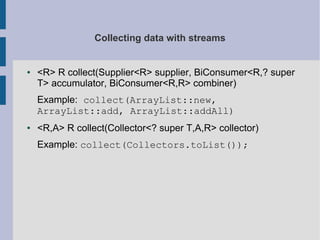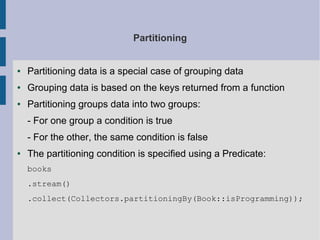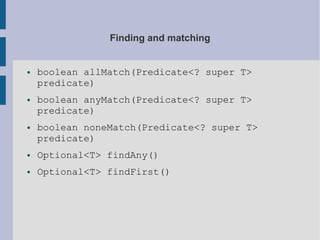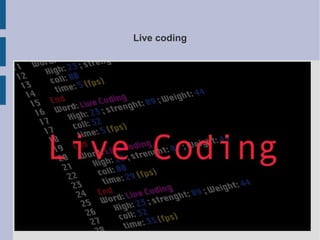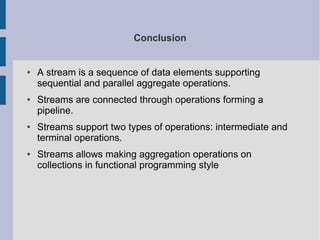Functional programming with streams
- 1. Functional Programming with Streams Prepared by: Riadh MNASRI
- 2. Who am I ? ● Riadh MNASRI ● Senior Java Developer ● Senior Kotlin Developer ● Interested By : - TDD, BDD, DDD, … - Clean Code - Functional Programming ● Twitter : @riadhmnasri
- 3. Agenda ● Whats Streams are ? ● Stream operations ● How to create streams ● Applying different operations with streams ● Collecting data with streams ● Grouping ● Partitioning ● Finding and matching ● Conclusion ● References
- 4. What Streams are ? ● A stream is a sequence of data elements supporting sequential and parallel aggregate operations. ● Consumes elements from its data source ● Focus on aggregagte computations ● Have no storage ● Can represent a sequence of infinite elements ● Support functional programming ● Stream are not reusable
- 5. Stream operations ● Intermediate operations: lazy operations ● Terminal operations: eager operations
- 6. How to create streams ? ● Streams from values: Stream<String> stream = Stream.of("Hello"); ● Empty streams : Stream.empty(); ● Streams from functions: Stream.iterate(1L, n -> n + 1); Stream.generate(Math::random); ● Streams from arrays: Arrays.stream(new int[]{1, 2, 3}); ● Streams from collections: list().stream() ● Streams from files: Files.lines(path) ● Streams from other sources: Pattern.compile(",").splitAsStream(str);
- 7. Applying different operations with streams ● Debuging stream: peek() ● Applying foreach: forEach(Consumer<? super T> action) ● Applying map (one to one mapping): <R> Stream<R> map(Function<? super T,? extends R> mapper) ● Flatenning (one to many mapping): flatMap(n -> Stream.of(n, n * n)) ● Filtering: filter(p -> p.getIncome() > 5000.0) ● Reducing: reduce(0.0, Double::sum);
- 8. Collecting data with streams ● <R> R collect(Supplier<R> supplier, BiConsumer<R,? super T> accumulator, BiConsumer<R,R> combiner) Example: collect(ArrayList::new, ArrayList::add, ArrayList::addAll) ● <R,A> R collect(Collector<? super T,A,R> collector) Example: collect(Collectors.toList());
- 9. Grouping ● In the most generic version, the groupingBy() method takes two parameters: - A classifier that is a function to generate the keys in the map. - A collector that performs a reduction operation on the values associated with each key: collect(Collectors.groupingBy(Person::getGen der, Collectors.counting()));
- 10. Partitioning ● Partitioning data is a special case of grouping data ● Grouping data is based on the keys returned from a function ● Partitioning groups data into two groups: - For one group a condition is true - For the other, the same condition is false ● The partitioning condition is specified using a Predicate: books .stream() .collect(Collectors.partitioningBy(Book::isProgramming));
- 11. Finding and matching ● boolean allMatch(Predicate<? super T> predicate) ● boolean anyMatch(Predicate<? super T> predicate) ● boolean noneMatch(Predicate<? super T> predicate) ● Optional<T> findAny() ● Optional<T> findFirst()
- 12. Live coding
- 13. Conclusion ● A stream is a sequence of data elements supporting sequential and parallel aggregate operations. ● Streams are connected through operations forming a pipeline. ● Streams support two types of operations: intermediate and terminal operations. ● Streams allows making aggregation operations on collections in functional programming style
- 14. References ● Book - Beginning Java 8 langugage features ● https://stackify.com/streams-guide-java-8/ ● Examples are available in my personal github : https://github.com/riadh-mnasri/bbl-java-stream-api





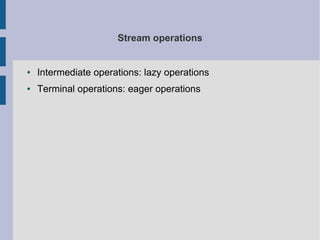
![How to create streams ?
● Streams from values:
Stream<String> stream = Stream.of("Hello");
● Empty streams : Stream.empty();
● Streams from functions:
Stream.iterate(1L, n -> n + 1);
Stream.generate(Math::random);
●
Streams from arrays: Arrays.stream(new int[]{1, 2, 3});
● Streams from collections: list().stream()
● Streams from files: Files.lines(path)
● Streams from other sources:
Pattern.compile(",").splitAsStream(str);](https://image.slidesharecdn.com/functional-programming-with-streams-v2-200728203729/85/Functional-programming-with-streams-6-320.jpg)

